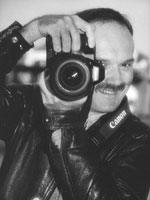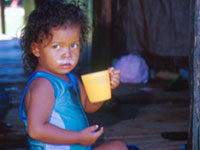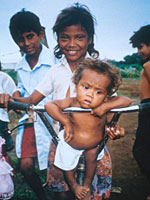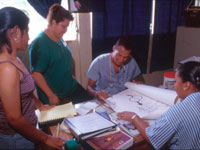|
July 21, 2005
Doctors without Borders - Journey into the
World of Humanitarian Aid
Just yesterday I completed an interview with Doctors
Without Borders/ Médécins Sans Frontières
(MSF) and while researching their website, I found that some of
the volunteers at MSF
had written really interesting stories about their experiences in
foreign countries. MSF gave me the permission to republish some
of these stories, I think you'll find them very interesting since
they shed light on the situation of the local population and the
experiences of the volunteers in some of these far away places.
Journey into the World of Humanitarian Aid
By Brian K. Smith
As I flew over Cuba, a goal I had set eight months earlier was
realized — I wanted to see this vibrant country that has a
rich cultural and musical presence in Canadian society. The view
of Cuba was short (only three minutes), and at 32 000 feet it was
a little high to absorb any of the sounds or smells of this island
country. On we raced across the Caribbean Ocean to Nicaragua above
the beautiful turquoise blue.

Brian Smith
This trip had its beginning fourteen months earlier when a kind
Quebec doctor from Médecins Sans Frontières had given
me and a video cameraman permission to get on a Red Cross medical
evacuation flight out of Afghanistan to Pakistan. We had been left
behind earlier in the day by the United Nations because we had too
much equipment for their overcrowded twin prop plane. I was very
grateful to MSF because after eight days in Afghanistan, my health
had started to rapidly deteriorate.
MSF has an office in Vancouver, and in April this year they had
an information night at Vancouver General Hospital. I decided to
attend, hoping there was something I could offer to this international
organization. A few weeks later, I couriered a portfolio of my work
to the head office in Toronto. This included medical and corporate
photography from St. Paul's Hospital, and a selection of my travel
photos from third world countries I had visited. I included a profile
of my professional memberships and associations in the photographic
world. I also have Spanish as a second language. My proposal to
MSF was to help them through my experiences. The realization many
years ago that my life's passion was photography has made me want
to share this gift with organizations like MSF, and also to help
young aspiring photographers realize their dreams.
In my carry-on luggage, I had a variety of Canon camera gear, and
a large bag of film from Kodak Canada donated to this project. I
also carried my itinerary for the thirteen days I would spend in
Nicaragua. I wanted to make sure I didn't arrive to a group of very
busy people who would look at me in a confused way, saying they
had no idea why I was there. The flight was a perfect low-level
approach to Managua — just skimming under the bottom of threatening
thunderheads. I noticed as I got off the plane there was the classic
CIA agent sitting three rows behind me. He watched everyone while
he sucked on his lollipop. I never did see him come through customs
and immigration. I breathed deeply as I step onto the Nicaragua
soil. The smell of Central America filled my nose — the hot
humid air was heavy in my lungs. Every place has its own particular
smell. I waddled through the congestion of taxi drivers, with my
heavy bags to my MSF driver. He was the only one in the crowd that
knew my name. Once we got inside the unmarked truck, I double-checked
that it was my name he had said! Ronald only spoke Spanish, so I
had to become quickly functional after a five-year hiatus from speaking
this foreign language. We understood each other well enough. Twenty
minutes later, we arrived at the MSF head office. I was greeted
by the receptionist Casta, who introduced me to Liz Steele, financial
administrator for MSF Nicaragua. Liz introduced me to the Director
of the mission, Chus Alonso. As Director, she coordinates the different
projects throughout Nicaragua that are sponsored by MSF Belgium
and Switzerland. These are the countries that sent me to Nicaragua
through the head office in Toronto. I was taken to my accommodations
on the outskirts of Managua.

On Tuesday, September 7th, 1999, I started my tours of the camps
created by the devastation of hurricane Mitch (October 1998). The
first settlement I went to was Nueva Vida (new life). The displaced
people in this small village had lived on the shores of Lake Managua
for many generations before the hurricane struck. The storm raised
the level of the lake five meters — ten months later it was
still many meters above normal. We traveled to Mateare, just outside
of Managua, to look at sanitation and water projects. The MSF staff
explained to me in great detail about the projects they were working
on. This included the complications created by local and national
governments, and the dedication and sometimes burnout of MSF staff
dealing with these logistics. The hurricane devastated about one
half of Nicaragua. A steady torrent of rain fell unceasingly for
an entire week.
On Wednesday, we headed off to Chinandega, two and a half-hours
northwest of Managua. Between Leon and Chinandega, we stopped at
the side of the highway to view an earth filled home. A six-member
family parished inside when Casita Volcano's lake spilled over the
top of the mountain and set off a huge landslide/mudflow that obliterated
three villages. It resulted in the loss of two thousand lives. Shortly
after we arrived in Chinandega, Andre, head of administration, took
me to Limonal Chinandega refugee camp. What is seen at first looks
okay, a fertile river delta where the displaced people live, but
after three hours of touring what was not so apparent was shocking.
Surrounding these poor people is a river contaminated by the garbage
dump. The garbage dump and cemetery directly drain through the soil
of the camp — this is not to be outdone by the holding lake
for the city sewer and nearby slaughterhouse. During heavy rains,
this lake overflows directly into the camp. I will never forget
the nauseating smell in the garbage dump.

The next morning I toured the center of Managua with two MSF doctors
who work on the Street Children Project. These abandoned or runaway
children make their lives by whatever means they can, from stealing
to prostitution. All of them are glue inhalers — it deadens
their pain of this seemingly hopeless situation. We met about twenty
kids in three different locations. A lot of tension exists between
the merchants and the children; however, I could immediately see
the trust bond that exists between the MSF staff and these kids.
In the afternoon, I went on a one-hour flight to the Caribbean
Coast. My destination was the Great Corn Island. This tropical paradise
is feeling the effects of the drug trade from South America. There
I documented the HIV/AIDS seminar that was hosted by MSF at the
island's hospital. The participants included hospital staff, nurses,
and the doctor.
I went to Bluefields on the Mosquito Coast the following day. This
was a magical place for me. It is a mix of Spanish, Creole, and
Afro Indian people. Most speak a funky, Jamaican style of English
in addition to Spanish. The MSF staff gave up their five-day holiday
to tour me around in their panga (small boat). Our trip to Pearl
Lagoon was incredible. We travelled along a canal bordered by a
lush growth of mangrove trees and palms. This fresh body of water
is huge, and at its end, is the village of Orinoco. It has a population
of fifteen hundred people. Two teenagers guided us from house to
house through the village. I didn't hesitate to ask everyone I met
if I could photograph him or her. We went to one other village before
turning around - Tasbapouni. After one hour of photographing many
of the inhabitants, a village representative questioned me about
my motives. My guide told him that I was with a human rights organization.
This definitely didn't go over well. I quickly corrected him, and
clarified that I was with a humanitarian group. I was permitted
to continue. Whether it was this situation or the afternoon heat,
it left me totally drenched in sweat. My MSF companions in comparison
seemed fine — this must be an effect of my thick Canadian
blood. To compensate, we drank fresh coconut milk in the sweltering
afternoon sun. The return journey back to Bluefields that day was
surreal. We glided down the waterway with a fiery sunset to the
west behind huge thunderheads. Mangroves and palms framed the scene
perfectly.
I stayed an extra day in Bluefields and was rewarded by an exciting
afternoon of photography in the Town Square. Everyone was dressed
in uniforms for the independence celebration. That evening we drove
to a mountain view-point, to the west of Bluefields to witness the
sunset over the jungle. A spectacular and fitting end to my Caribbean
sojourn.
The following morning, I had an early flight back to Managua. After
checking into the MSF house, I caught a bus to Granada. Unfortunately,
it was totally closed for the holiday. For many centuries, it had
been the grandest city in the Americas. In 1857, an American, who
had corruptly proclaimed himself president of Nicaragua, was forced
to flee Granada. Upon his departure, he set the city on fire, loosing
this treasure of the Americas forever. The present city has a stately
appearance, but lacks a feeling of its five centuries of history.

On September 16th, my driver, Gustavo, and I departed on a six-hour
journey to Nueva Segovia - the most northern province. The purpose
of our trip was to visit Casa Materna in the mountainous village
of Quilali. On our way we past fields of rice and tobacco. The winding
road became rough and narrow as we climbed through the mountains
towards the Honduran border. More than once we were surprised to
find a herd of cattle greeting us around a sharp canyon corner.
Devastation from hurricane Mitch was still very evident along the
scared Rio Coco, the largest river in the province. The riverbank's
raw edges were clear of vegetation fifteen meters above its present
level. Most settlements along rivers in this northern frontier province
were swept away. During my first day in Quilali, I visited the San
Bartolo camp with the MSF staff. MSF constructed wells that the
local people can easily maintain and service themselves. They were
also showing the inhabitants how to make cement construction bricks.
These are used for the building of solid, rain resistant homes,
and for the lining of wells and outhouse toilets.
My last assignment was to visit Casa Materna, a complex containing
diagnostic quarters with a prenatal classroom, and a delivery room.
Up to twelve women can stay there at one time. This is mainly for
high-risk pregnancies in the third trimester. Many of the patients
are young teenagers. The atmosphere within is calm and soothing.
Before leaving for Managua, I took a walk along the back streets
of Quilali. Families invited me into their yards to photograph them.
At noon, Gustavo and I departed in the Land Rover jeep for our trip
back to Managua. I felt sad that this incredible journey was coming
to a conclusion. MSF had provided an unforgettable personal experience
— the most memorable of all my travels.
As my flight took me northeast over Nicaragua towards Miami, I
reflected on the past thirteen days. The MSF staff had immediately
made me feel like part of the team. Thorough briefings on the history
and current situations that they shared with me made this trip an
educational experience. The Nicaraguan people demonstrated an incredible
resilience to situations that are very difficult to tolerate. Through
the dedication and hard work of the MSF staff the quality of life
is gradually improving for these people.
I am very grateful to have the opportunity to show the world through
my photography how MSF is making a big difference to those who are
in need of humanitarian aid.
By Brian K. Smith
www.msf.ca
Related Articles:
Read my interview with Doctors
without Borders
Doctors without Borders: Visiting
an Afghan Refugee Camp
Doctors without Borders: El Salvador,
after the Earthquake
Doctors without Borders: Water
for Ixtahuacan
Doctors without Borders: Visiting
MSF in Sierra Leone
Doctors without Borders: Lost between River
and Sky
Doctors without Borders: Journey
into the World of Humanitarian Aid
|